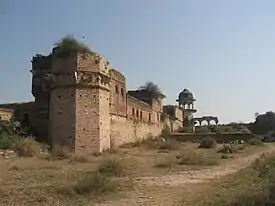Gohad State | |||||||||
|---|---|---|---|---|---|---|---|---|---|
| 1505–1805 | |||||||||
 Gohad near north side of Gwalior | |||||||||
| Capital | Gohad | ||||||||
| Common languages | Hindi | ||||||||
| Maharaj Rana | |||||||||
• 1505–1518 (first) | Singhandev II | ||||||||
• 1803–1805 (last) | Kirat Singh | ||||||||
| Historical era | Medieval India | ||||||||
• Established | 1505 | ||||||||
| 1805 | |||||||||
| |||||||||
| Today part of | India · Madhya Pradesh | ||||||||


Gohad State or Kingdom of Gohad was a Jat kingdom in India.[1] It was founded by Jat King Singhadev II. The state was ruled by Bamraulia Jats.[2]
History
After the death of Aurangzeb, Singhadev II established Jat rule in Gohad near Gwalior in 1711 and founded the Gohad kingdom.[3] Bhim Singh Rana was the most famous ruler of Gohad. He defeated the Mughals and captured Gwalior, under his reign 331 forts were captured.[4] Bhim Singh Rana also defeated the Marathas. After his death Chatar Singh recaptured Gwalior from the Marathas on 1780.[5] He ruled from Gwalior till 1785. In 1785 Maratha ruler Mahadaji Shinde again captured Gwalior and also captured Gohad destroying the Jat kingdom temporarily. After Mahadaji Shinde's death 18 years later, Kirat Singh assumed power and became the ruler of Gohad. Kirat Singh exchanged the territory of Gohad with Dholpur in a treaty with the Marathas who were continuously attacking the Jat kingdom. He also gave up on trying to recapture Gwalior and gave it to the Marathas as part of the treaty.[6]
Rulers
- Singhandev II (1505-1524)
- Devi Singh (1524-1535)
- Udyaut Singh (1535-1546)
- Anup Singh (1546-?)
- Shambhu Singh (?-1604)
- Abhaychandra (1604-1628)
- Ramchandra (1628-1647)
- Ratan Singh (1647-1664)
- Uday Singh (1664-1685)
- Bagh Raj (1685-1699)
- Gaj Singh (1699-1704)
- Jaswant Singh (1704-1707)
- Bhim Singh Rana (1707-1756)
- Girdhar Pratap Singh (1756-1757)
- Chhatar Singh (1757-1785)
- Kirat Singh (1803-1805)
See also
References
- ↑ Insight Guides (2017). Insight Guides Rajasthan. Rough Guides UK. ISBN 9781786717139. Retrieved 21 February 2022.
- ↑ Chaurasia, R.S. (2004). History of the Marathas. Atlantic Publishers & Dist. p. 176. ISBN 9788126903948. Retrieved 21 February 2022.
- ↑ "Great Britain. Commonwealth Office". The Imperial Gazetteer of India: Coondapoor to Edwardesābād (reprint ed.). Today & Tomorrow's Printers & publishers. 1908. p. 324. Retrieved 22 February 2022.
- ↑ TL, Prabhu (2019). Majestic Monuments of India: Ancient Indian Mega Structures. Nestfame Creations Pvt. Ltd. Retrieved 22 February 2022.
- ↑ Abraham Valentine Williams Jackson, ed. (1906). History of India, Volume 4. Grolier Society. Retrieved 22 February 2022.
- ↑ "Sir William Wilson Hunter, James Sutherland Cotton, Sir Richard Burn, Sir William Stevenson Meyer, Great Britain. India Office". Imperial Gazetteer of India, Volume 11. Clarendon Press. 1908.